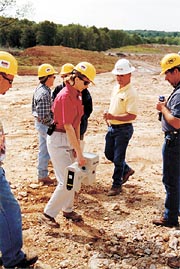
Attending the event were directional drilling contractors, engineering firms and even a water well drilling contractor.
When asked how the seminar/demo came to be, Todd Taylor, vice president at Halco America Inc. tells us, “We were looking for a rig manufacturer to rent us a drill rig for a rock drilling seminar. The CME folks had a rig as well as a site we could use (Fred Weber Quarry in Foley, Mo.), so we went into it as partners.

Using the CME-50DD rig and Halco’s Storm 500 hammer, drilling started out at negative 27 degrees in 12,000 psi limestone. After going 240 feet, the hammer came out at plus 15 degrees. The drilling speed was 60 feet to 70 feet per hour for the pilot bore, which was a 51⁄2-inch bore. Then a reamer was attached, which expanded that 51⁄2-inch hole to a 10-inch hole at a rate of about 2 feet per minute.
Eileen Robinson of Digital Control Inc. was on hand to provide information about iGPS locators. “A lot of people don’t really understand the locating equipment,” she notes. “We were just trying to demo the tool’s steerability and the fact that you can see how much the tool has responded by the way that the Eclipse tracked its position and its heading. As soon as the tool’s orientation changes just a little bit, you really see that in the locate point. So that was impressive for people to track the position of a tool and to know – quickly – whether the heading is going off-line or not – even on a very small steering correction.”
Besides educating others, Robinson also wanted to learn. “I was anxious to see the new Halco percussion tool,” she explains. “Our transmitters are riding inside of these percussion instruments and they weren’t killing our transmitters, so they had to be doing something right. I really was curious to see what Halco had done to modify the transmitter compartment to make it so shock absorbent that we weren’t seeing failures of our equipment. I also was impressed with overall performance – the steering and the penetration rate.”

Echoing the sentiment of the day, Robinson says, “I think the participants were impressed with everything; it was a great field demo.”
For more information on the Storm 500 hammer from Halco, the CME-50DD drill rig and the DigiTrak Eclipse tracking system, check out this issue’s “Product Information” section.
Another rock drilling school is being planned for the fall; details will be passed along when available.
Report Abusive Comment